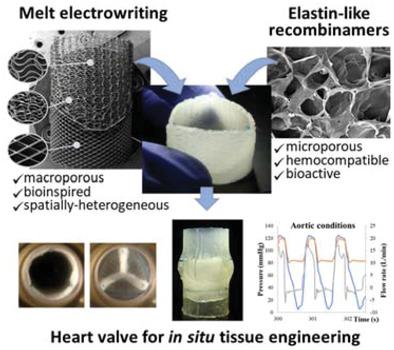当前位置:
X-MOL 学术
›
Adv. Funct. Mater.
›
论文详情
Our official English website, www.x-mol.net, welcomes your
feedback! (Note: you will need to create a separate account there.)
Spatially Heterogeneous Tubular Scaffolds for In Situ Heart Valve Tissue Engineering Using Melt Electrowriting
Advanced Functional Materials ( IF 18.5 ) Pub Date : 2022-02-15 , DOI: 10.1002/adfm.202110716 Navid Toosi Saidy 1 , Alicia Fernández‐Colino 2 , Behzad Shiroud Heidari 3, 4, 5 , Ross Kent 1 , Michael Vernon 3, 4, 5 , Onur Bas 1, 6 , Shane Mulderrig 2 , Andreas Lubig 2 , José Carlos Rodríguez‐Cabello 7 , Barry Doyle 3, 5 , Dietmar W. Hutmacher 1, 6, 8 , Elena M. De‐Juan‐Pardo 4, 5, 9 , Petra Mela 2, 10
Advanced Functional Materials ( IF 18.5 ) Pub Date : 2022-02-15 , DOI: 10.1002/adfm.202110716 Navid Toosi Saidy 1 , Alicia Fernández‐Colino 2 , Behzad Shiroud Heidari 3, 4, 5 , Ross Kent 1 , Michael Vernon 3, 4, 5 , Onur Bas 1, 6 , Shane Mulderrig 2 , Andreas Lubig 2 , José Carlos Rodríguez‐Cabello 7 , Barry Doyle 3, 5 , Dietmar W. Hutmacher 1, 6, 8 , Elena M. De‐Juan‐Pardo 4, 5, 9 , Petra Mela 2, 10
Affiliation

|
Heart valve tissue engineering (HVTE) aims to provide living autologous heart valve implants endowed with regenerative capabilities and life-long durability. However, fabrication of biomimetic scaffolds capable of providing the required functionality in terms of mechanical performance and tunable porosity to enable cellular infiltration remains a major challenge. Here, the additive manufacturing of bioinspired, spatially heterogeneous, tubular scaffolds enclosing the leaflets, inter-leaflet triangles, and their interface for in situ HVTE using melt electrowriting (MEW) is demonstrated. The innovative platform enables the digital fabrication of scaffolds with ad hoc architecture (e.g., tunable location, specific fiber pattern, and orientation) and customizable geometry via a custom-made control software. The user-friendly interface allows for the definition of areas of the scaffold with specific patterns to obtain properties such as tunable J-shaped stress–stain curve and anisotropy typical of the heart valve leaflet, compliant inter-leaflet triangles, and reinforced curvilinear boundary between them. Heterogeneous, tubular, heart valve MEW scaffolds are then embedded with a microporous elastin-like recombinamer (ELR) hydrogel to develop a soft-network composite favoring cell infiltration and ensuring hemocompatibility. The acute systolic hemodynamic functionality of the MEW/ELR composite satisfies the ISO 5840 requirements, under aortic and pulmonary conditions.
中文翻译:

用于原位心脏瓣膜组织工程的空间异质管状支架使用熔体电写
心脏瓣膜组织工程 (HVTE) 旨在提供具有再生能力和终身耐用性的活体自体心脏瓣膜植入物。然而,制造能够在机械性能和可调孔隙率方面提供所需功能以实现细胞浸润的仿生支架仍然是一项重大挑战。在这里,展示了使用熔融电写 (MEW) 进行原位 HVTE 的仿生、空间异质、管状支架的增材制造,该支架包围小叶、小叶间三角形及其界面。该创新平台通过定制的控制软件实现了具有临时架构(例如,可调节位置、特定纤维图案和方向)和可定制几何形状的支架的数字化制造。用户友好的界面允许定义具有特定模式的支架区域,以获得诸如可调谐 J 形应力-染色曲线和心脏瓣膜瓣叶典型的各向异性、顺应性瓣叶间三角形和加强曲线边界等特性。他们。然后将异质管状心脏瓣膜 MEW 支架嵌入微孔弹性蛋白样重组体 (ELR) 水凝胶,以开发有利于细胞浸润和确保血液相容性的软网络复合材料。MEW/ELR 复合材料的急性收缩期血流动力学功能在主动脉和肺部条件下满足 ISO 5840 要求。合规的传单间三角形,并加强了它们之间的曲线边界。然后将异质管状心脏瓣膜 MEW 支架嵌入微孔弹性蛋白样重组体 (ELR) 水凝胶,以开发有利于细胞浸润和确保血液相容性的软网络复合材料。MEW/ELR 复合材料的急性收缩期血流动力学功能在主动脉和肺部条件下满足 ISO 5840 要求。合规的传单间三角形,并加强了它们之间的曲线边界。然后将异质管状心脏瓣膜 MEW 支架嵌入微孔弹性蛋白样重组体 (ELR) 水凝胶,以开发有利于细胞浸润和确保血液相容性的软网络复合材料。MEW/ELR 复合材料的急性收缩期血流动力学功能在主动脉和肺部条件下满足 ISO 5840 要求。
更新日期:2022-02-15
中文翻译:

用于原位心脏瓣膜组织工程的空间异质管状支架使用熔体电写
心脏瓣膜组织工程 (HVTE) 旨在提供具有再生能力和终身耐用性的活体自体心脏瓣膜植入物。然而,制造能够在机械性能和可调孔隙率方面提供所需功能以实现细胞浸润的仿生支架仍然是一项重大挑战。在这里,展示了使用熔融电写 (MEW) 进行原位 HVTE 的仿生、空间异质、管状支架的增材制造,该支架包围小叶、小叶间三角形及其界面。该创新平台通过定制的控制软件实现了具有临时架构(例如,可调节位置、特定纤维图案和方向)和可定制几何形状的支架的数字化制造。用户友好的界面允许定义具有特定模式的支架区域,以获得诸如可调谐 J 形应力-染色曲线和心脏瓣膜瓣叶典型的各向异性、顺应性瓣叶间三角形和加强曲线边界等特性。他们。然后将异质管状心脏瓣膜 MEW 支架嵌入微孔弹性蛋白样重组体 (ELR) 水凝胶,以开发有利于细胞浸润和确保血液相容性的软网络复合材料。MEW/ELR 复合材料的急性收缩期血流动力学功能在主动脉和肺部条件下满足 ISO 5840 要求。合规的传单间三角形,并加强了它们之间的曲线边界。然后将异质管状心脏瓣膜 MEW 支架嵌入微孔弹性蛋白样重组体 (ELR) 水凝胶,以开发有利于细胞浸润和确保血液相容性的软网络复合材料。MEW/ELR 复合材料的急性收缩期血流动力学功能在主动脉和肺部条件下满足 ISO 5840 要求。合规的传单间三角形,并加强了它们之间的曲线边界。然后将异质管状心脏瓣膜 MEW 支架嵌入微孔弹性蛋白样重组体 (ELR) 水凝胶,以开发有利于细胞浸润和确保血液相容性的软网络复合材料。MEW/ELR 复合材料的急性收缩期血流动力学功能在主动脉和肺部条件下满足 ISO 5840 要求。















































 京公网安备 11010802027423号
京公网安备 11010802027423号